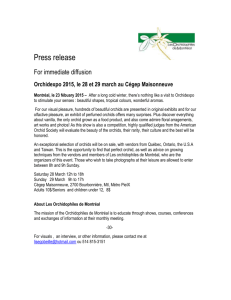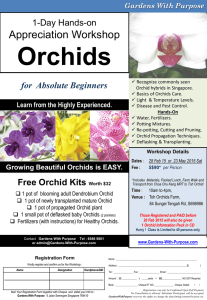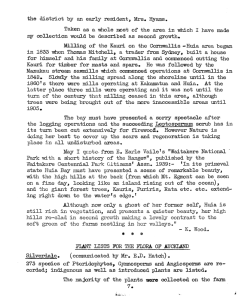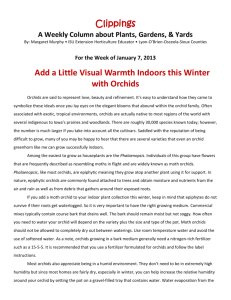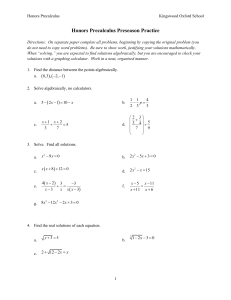Akarsh_lake2006_29th DEc2006
advertisement
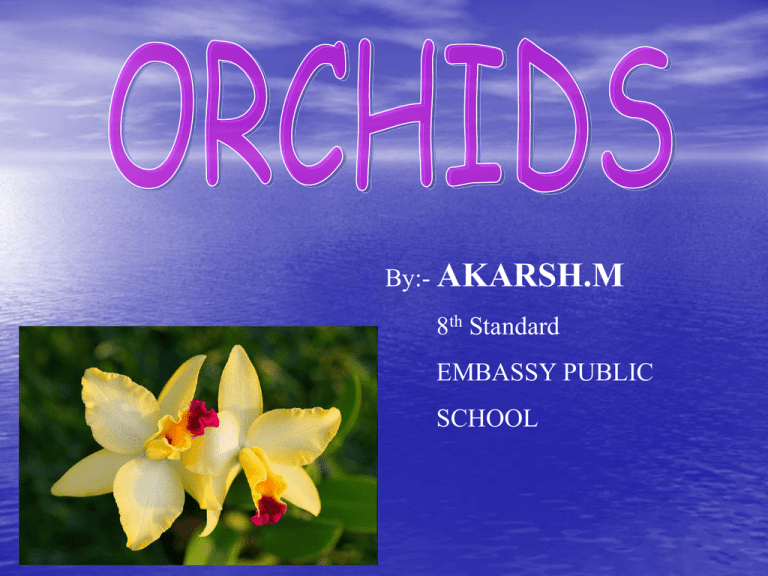
By:- AKARSH.M 8th Standard EMBASSY PUBLIC SCHOOL CONTENTS INTRODUCION HISTORY GEOGRAPHICAL DISTRIBUTION HABIT AND AHBITAT LEAF STEM ROOTS FLOWER REPRODUCTION GROWING OF ORCHIDS USES OF ORCHIDS VANILLA MEDICINAL USES CASE STUDY CONCLUSION INTRODUCTION • • Orchids (Orchidaceae family) are the largest and most diverse of the flowering plant (Angiospermae) families, with 800 described genera and 35,000 species. Some sources give 30,000 species, but the exact number is unknown since classification differs greatly in the academic world. HISTORY • The ancient Greeks were the first to • take note of these strange plants. Theophrastus who is often called as father of Botany gave the name “Orchids” to these groups of plants on the basis of the resemblance of paired underground tubers of these plants to masculine anatomy. Indian Vedic scripture also mention about these plants under the name “Vrinda”, the Sanskrit name of orchids. GEOGRAPHICAL DISTRIBUTION • Orchids are found everywhere, majority of the orchids known are natives of tropical countries and occur in their greatest diversity in humid tropical forests. • India has about 1,600 species, out of which about 200 are found in South India especially in the Western Ghats and in Assam nearly 800 species are known. • However, nowhere else are orchids in so much abundance and so beautiful as along the 1,500 mile Himalayan belt Kalimpong which is rightly called as ‘Orchid Heaven’. HABIT AND HABITAT • Orchids are perennial herbs with • • simple leaves clustered all along the stem. They usually have fleshy or swollen stems called as pseudobulbs and on the basis of their growth pattern they are classified as monopodial (single) or sympodial orchids (many). In many a cases orchids are valued for their leaves instead of their flowers and are called jewel orchids. Orchids mostly grow as epiphytes i.e. adhering to the main stem or branches of different plants or moss-covered rocks fixing themselves with their strong roots. Orchids represent all the possible colours. However , there is no black orchid which exists only in fairy tales. LEAF • Orchids have simple leaves with • • • parallel veins. The leaves can be enormous or minute, or they can even be lacking. The leaves of most orchids live on, attached to their pseudobulbs, for several years. The leaves of some species can be most beautiful STEM • The stem of an orchid determines the habit of the species. Each type of stem can grow in one of these two ways: • Monopodial (“one-footed”) growth. The new shoots grow upwards from a single stem, originating in the end bud of the old shoots. • Sympodial (“many-footed”) growth. The plant produces a series of adjacent shoots which grow to a certain size, bloom, then stop growing, to be replaced by the next growth. ROOTS • All orchids are perennial herbs, lacking • • any permanent woody structure. Some orchids are terrestrial, growing rooted in the soil. Terrestrial orchids may be rhizomatous. These act as storage organs for food and water. Terrestrials are mostly found in colder climates. A great many orchids are epiphytes, which do not require soil and use trees for support. They occur in warmer regions. Epiphytic orchids have modified aerial roots which help them to absorb the moisture from the atmosphere. The aerial roots of epiphytes that lack leaves have an additional function. They contain chlorophyll and take up carbon-dioxide. FLOWER • The orchid flowers are irregular, extremely variable in size and shape with sparkling texture; they emit the fragrance of lemons, cloves or fresh lavender oil. • The flower has its part in threes, 3 sepals and 3 petals (collectively called as tepals) , similar to each other and sub similar to sepals. • The third petal is different and distinctive and is called labellum or the lip. REPRODUCTION • The reproductive organs of the orchids, the stamens and the pistil are condensed and form a complex body the column. • Orchids are cross-pollinated by insects, birds etc, and to achieve this they have adored many contrivances like mimicry and twisting of the flower on its stalk to face its pollinating agent. • The seeds of orchids are extremely small and minute-like powder. A million of them are found in one capsule and are scattered by wind when the fruit bursts open. GROWING OF ORCHIDS • Orchids need aeration, good drainage, much humus and humidity. Depending upon the growth habitat the orchids are classified as epiphytic or terrestrial, the orchids. • The orchids are best watered by indirect methods like spraying or sprinkling. Coconut water is very good for the growth of orchids. • Orchids in general grow better if undisturbed. It is rightly said that orchids die in most of the cases on account of over care than neglect. USES OF ORCHIDS • Orchids are well known mainly as • • • • ornamentals, some of them are said to be of high medicinal value. Salep from orchid tubers has been used for centuries as emollient, demulcent and as aphrodisiac. Sap of some of the species is supposed to be highly styptic. The famous Vanillin used for flavouring ice creams and delicacies throughout the world comes from the pods of an orchid Vanilla planifolia. Lastly, mention must be made about the recently discovered fungistatic compounds called “Phytoalexins” which were first discovered in orchids, these are naturally produced fungicides by plant in response to fungal infection. VANILLA • Vanilla, Vanilla planifolia (and other • • two Vanilla species less commonly grown), is used as a flavouring agent which gives a cooling effect. Madagascar is the leading producer, producing in 2005, 3 million metric tons (of a world total of 7.3 million metric tons). Besides its use as a flavouring, It is also used in fragrances and perfumes. MEDICINAL USES Many of the orchids have a medicinal value like some listed below Bletilla striata- This plant is used as herbal medicine in Chinese Materia Medica for the treatment of dysentery, fever, malignant ulcers, gastrointestinal disorder, anthrax, malaria, eye diseases, ringworm, tumers, coughs, chest pains etc. Cypripedium pubescens- It has sedative, hypnotic, antispasmodic properties and it is an excellent nervine tonic. It is used against stress, helps to elevate mood, depression and eases muscles. Dendrobium- Malaysians have used this plant for affections of the brain and nerves. The flowers and leaves are useful for cholera. The powdered leaves have been used for decreasing pimples. Gastrodia elata- It has been included in the Chinese Materia Medica and guides over the centuries and attributed to possess magical properties such as expelling all kinds of poisons, giving strength and virility, improving circulation and memory. Vanda roxburghii- The plant is reported to have anti-inflammatory properties and is widely used against arthritis. Vanda tesellata- Whole plant contains an unknown glucoside which stimulates all the organs of the body and therefore used in medical preparations especially arthritis. CASE STUDY A case study was conducted on the medicinal usage of orchids. The study reports that fresh rhizomes and aerial parts of orchids are commonly used to cure human and veterinary diseases by tribes like Kondareddies, Koyas, Valmikis, Nukadoras and Yanadis etc. Acampe praemorsa Uses: Whole plant is crushed with egg albumin and calcium paste applied tied with bandaging for settling fractures by Koyas. Bulbophyllum neilgherrense Uses: Tubers of this plant are consumed for good health by Valmikis. Cymbidium aloifolium Uses: Aerial roots made into paste and plastered tightly on fractured bones and also to cure foot cracks by Koyas. Mucilage from the leaves helps to stop bleeding after a leech bite. Dendrobium herbaceous Uses: Tender tip juice is used for earache by Nukadoras and Valmikis. Habenaria plantaginea Uses: Tubers ground with black pepper and garlic used to cure chest pain and stomach ache by Koyas. Habenaria hollandiana Uses: Fresh plant paste applied for scorpion sting by Kondareddies and Valmikis. Geodorum densiflorum Uses: Root paste used to cure insect bite and wounds. Habenaria roxburghii Uses: Tubers with garlic and pepper used to cure snake bite. Malaxis acuminate Uses: Pseudobulbs used in ‘Ayurveda’ system of medicine as ingredient of ‘Ashtawarga’ tonic preparation. Oberonia wightiana Uses: Leaves crushed with calcium, salt and turmeric paste tied with bandage for external tumors by Koyas. Vanda tesellata Uses: Dried stem burnt and fumes spread out in home prevent children from catching fever by Koyas. CONCLUSION Nature is the mother of all. There’s no orphan in the world until we are in her vigil. She can be regarded the best doctor, the best scientist and moreover the best mentor to teach the ways of life. She allows us decipher things on our own and in some other way we need to be grateful to her generosity. Orchids are one among her generous ways. To safeguard and protect them is our onus. Orchids have in varied uses and can replace any allopathic drugs sans side effects. Biopiracy is the prevailing tension and the government should encourage the research and development on orchids and make it more practical and available for the next filial. “Mother’s love has no equals”
